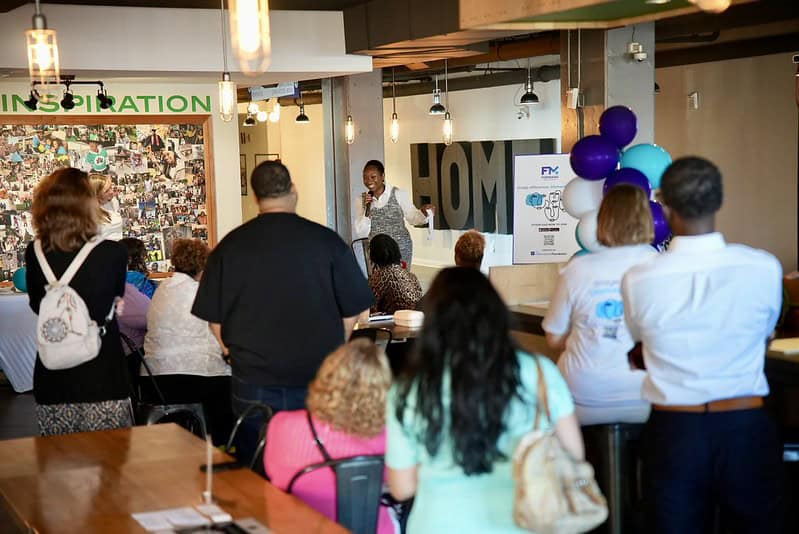
Forward Movement: A Digital Pathway Toward an Inclusive and Equitable Indianapolis
The Indianapolis Foundation launched the Forward Movement app, an evolution of Movement10K, to deepen learning around racial equity
(From left: Rob MacPherson, Brittany Laguerre, Leigh Riley Evans, and Dr. Michael R. Twyman)
When the Indianapolis Foundation (IF) first launched Movement10K (MVMT10K), the app was designed to help residents explore what it means to live out equity … to learn, reflect, and take action. Now, with the debut of Forward Movement, that mission continues with a broader, more inclusive vision.
“Forward Movement is a tangible outgrowth of the Foundation’s commitment to racial equity,” said Dr. Michael R. Twyman, IF Chief Equity and Innovation Officer. “We had the benefit of at least a year and a half to build the numbers, understand user experience, and rethink not only target audiences but how to make the app more accessible. It’s also a very real reflection of our environment; where we are as a society and how we continue to address issues of race.
“The goal is not only to educate but to activate users, to engage them on their individual journeys while growing a collective movement,” he added.
That commitment came with a major investment—over $1 million supported by donors aligned with the Foundation’s mission and vision.
“It was a significant investment,” said Leigh Riley Evans, IF Vice President of Equity and Policy. “We knew from evidence-based data that opportunity gaps and systemic disparities around race were real and persistent. To start transforming those disparities, we committed to using this digital tool to educate the community about anti-racism. Relaunching the app wasn’t just about technology. It was about demonstrating that this continues to be a priority for us and for our city.”
Creating Space for Connection & Belonging
With Forward Movement, the Indianapolis Foundation wanted to design something that felt both safe and engaging, creating an environment where people could learn at their own pace, without judgment.
“We’re really committed to using this as a tool for the community because it bridges differences,” said Brittany Laguerre, IF Opportunity, Equity, and Inclusion Officer. “It connects people who might never have otherwise been connected. We considered what it would take for people to lean into learning. That’s why we created bite-sized content and modified features that feel more accessible and relevant. The goal is to make this a tool that bridges differences across all identities.”
For Rob MacPherson, IF Vice President of Advancement, that bridge was built on years of internal learning. “Besides the money and building the platform, we’ve invested years in curating our own learning experiences at the Foundation. This started almost a decade ago … with undoing racism workshops, reading groups, podcasts like Scene on Radio’s Seeing White, and internal conversations,” MacPherson said. “Before the app existed, we were already being asked to share our journey. We weren’t experts. We were just people trying to learn together. The app became a way to automate this shared experience and make it available to anyone who wanted to join.”
From Exclusive to Inclusive
Early on, Movement10K was designed mainly for white audiences. “The original focus on white users came from a belief that white people had the responsibility to do this learning,” MacPherson said. “We didn’t want to burden people of color with that emotional work. But as time went on, we realized that everyone, regardless of race, needed to understand how these systems were created and why they continue to function as they do.”
Riley Evans added, “A digital app creates a safe space to learn privately, without shame or fear of saying the wrong thing. But expanding it to everyone helps ensure we’re not centering whiteness. It’s about learning together … creating space for all participants.”
That shift also reflects the current cultural moment, according to Twyman.
“We sometimes assume people of color automatically understand their history, but many don’t,” he said. “Most of us went to predominately white schools. Unless our families made sure we learned our own history, we may not even recognize when we’re being treated differently. Understanding that context helps everyone see why the system works the way it does, and why change still matters.”

A Movement of Collective Action
Ultimately, the Forward Movement app is about more than education. It’s about engaging and mobilizing communities.
“There’s power in numbers, and in like minds, to solve shared problems,” Twyman said. “This app creates space not only for learning but for mobilization. It helps people realize their experiences aren’t isolated. That awareness can bring hope, and that hope can fuel action.”
It also provides a path for learning as part of a personalized experience, Laguerre said.
“I want people to feel safe to learn, to feel seen in their experiences, and to know that what they’re doing matters,” she added. “This isn’t about doing something huge immediately. It’s about identifying one thing you can do in your sphere of influence and following through.”
Riley Evans agreed. “We hope this sparks conversations … conversations that turn into connections and, eventually, into action. Whether it’s supporting a policy, joining a dialogue, or taking a stand in your organization, Forward Movement helps make equity real through everyday practice.”
The goal is simple and straightforward: Empowerment, Laguerre said. “Sometimes people don’t even realize the power they already have. This app helps create space for people to see their own power, use it, and bring it to the table to shape a more inclusive city … and even beyond that, a more inclusive nation.”
Join the movement
The Forward Movement app is available now for free download on the App Store and Google Play. Learn more by clicking the link below.